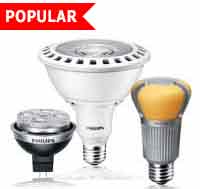How will light bulbs change? Here are some answers
The nation's new light bulb rules start taking effect Sunday. What exactly do they require, and what's their likely impact, since Congress barred funds to enforce the efficiency standards? Here are some answers:
Q: What's included in the new standards?
A: The standards require light bulbs be at least 25% more efficient and carry labels on the front and back of packages to explain their brightness, annual operating costs and expected life span.
The labels apply to all light bulbs made or imported after Jan. 1, but the efficiency standards apply only to traditional 100-watt incandescents on that day. The efficiency rules will begin applying to the old-fashioned 75-watt bulb in January 2013 and 40- and 60-watt bulbs in January 2014. Retailers can sell leftover bulbs as long as they weren't made or imported after their deadline.
Q: Do the standards ban all incandescents?
A: No. Edison's bulbs won't meet the rules, but the halogen incandescent will. So, too, will the CFL (compact fluorescent lamp) and the LED (light-emitting diode), each of which is at least 75% more efficient than the traditional incandescent. Also, the rules don't apply to less commonly used incandescents such as appliance, three-way and colored bulbs.
Q: Do these efficient alternatives have a yellowish light?
A: Not necessarily. The back of each light bulb package will list the "light appearance," or color, of the bulb, measured on a temperature scale known as Kelvin (K). Lower Kelvin numbers mean the light is more yellow, while higher numbers mean it's whiter or bluer.
The traditional incandescent, which gives off a warm and almost yellowish light, has a temperature of 2,700 to 3,000K — similar to most halogens. Newer CFLs have a wider range, from warm (2,700K) to cold (6,500K). LED temperatures range from 3,300K to 5,000K.
Q: What's all this talk about lumens?
A: Lumens, which will be listed on the front of a light bulb's package, are a measure of a bulb's brightness. In contrast, a bulb's wattage is a measure of its energy use. The more lumens, the brighter the light. The old 100-watt incandescent yields about 1,600 lumens, while the 40-watt bulb provides about 450 lumens.
Q: Do all the new bulbs contain mercury? How dangerous is that?
A: Halogens and LEDs don't contain mercury, but CFLs have trace amounts (an average 4 milligrams per bulb; older thermometers have about 500 milligrams). No mercury is released unless the bulb breaks, but if that happens, consumers need to take special precautions in cleaning up and disposing of the bulbs. The Environmental Protection Agency offers cleanup tips: http://www.epa.gov/cfl/cflcleanup.html#instructions.
"The concerns are overblown," says Ed Crawford, CEO of Philips Lighting North America. "There's more mercury in a plate of sushi than a CFL," he says, arguing that's why the U.S. government warns people not to eat too much tuna.
Q: Are more efficient bulbs dimmable?
A: Halogens and LEDs can be dimmed, but many cheaper CFLs cannot.
Source: US Today

















Comments